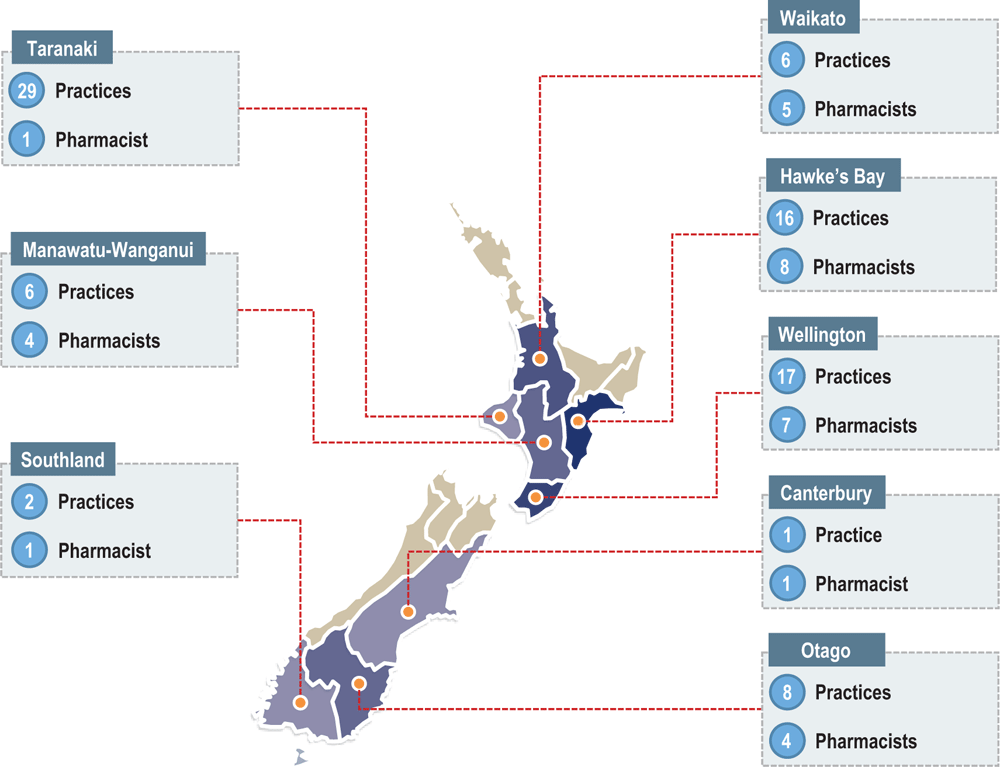Pharmacist integration into general practice in New Zealand
Robert Haua 1 2 , Jeff Harrison 1 , Trudi Aspden 11 School of Pharmacy, Faculty of Medical and Health Sciences, University of Auckland, Private Bag 92019, Auckland 1142, New Zealand.
2 Corresponding author. Email: r.haua@auckland.ac.nz
Journal of Primary Health Care 11(2) 159-169 https://doi.org/10.1071/HC18103
Published: 18 July 2019
Journal Compilation © Royal New Zealand College of General Practitioners 2019.
This is an open access article licensed under a Creative Commons Attribution-NonCommercial-NoDerivatives 4.0 International License.
Abstract
Introduction: Pharmacist integration into general practice is gaining momentum internationally, with benefits noted in reducing medication errors, improving chronic disease management and alleviating general practitioner workforce shortages. Little is known about how general practice pharmacists are working in New Zealand.
Aim: This study characterised the current landscape of pharmacist integration into general practice in New Zealand.
Methods: An online questionnaire was developed, piloted and distributed to all pharmacists in New Zealand.
Results: Thirty-six responses were analysed. Respondents were more likely to be female, have been pharmacists for at least 10 years and all but one held formal postgraduate clinical pharmacy qualifications. Seven pharmacists were working as pharmacist prescribers. Primary health organisations (PHOs) were the most common employer, with funding primarily derived from either PHOs or District Health Boards. Pharmacist integration into general practice appears to have progressed further in particular regions of New Zealand, with most respondents located in the North Island. Tasks performed by respondents included medication reviews, managing long-term conditions and medicines reconciliation. Increased job satisfaction compared with previous roles was reported by most respondents. Funding and a general lack of awareness about pharmacists’ professional scope were seen as barriers to further expansion of the role.
Discussion: This study describes the characteristics of pharmacists currently working in general practices in New Zealand and provides insights into key requirements for the role. Understanding the way practice pharmacists are currently employed and funded can inform general practices considering employing pharmacists.
Keywords: General practice; general practitioners; integration; intersectoral collaboration; pharmacist; primary health care
| WHAT GAP THIS FILLS |
| What is already known: Pharmacist integration into general practice is attracting attention internationally. Hawke’s Bay, Waikato, Otago and Southland regions of New Zealand have invested in having pharmacists integrated into general practice. Economic benefits attributed to practice pharmacists have been savings in medication costs and freeing up general practitioner time, alongside improvements to the quality of patient care in terms of reduced medication errors and improvements in chronic disease management. |
| What this research adds: Pharmacists working in general practices in New Zealand appear concentrated in certain regions. Pharmacists are performing patient-facing roles, quality improvement roles and roles aimed at improving practice efficiencies. In the absence of a guiding framework, various funding and employment models have emerged, but funding constraints are reported to be a major barrier to further expansion. Pharmacists responding to the questionnaire generally had a positive view of the role. |
Introduction
In New Zealand (NZ), the planning, purchasing and provision of health services is largely delegated to 20 geographically defined District Health Boards (DHBs).1 Thirty-one Primary Health Organisations (PHOs), funded by DHBs, deliver primary health-care services to their enrolled populations, primarily through general practices.2 Most practicing pharmacists in NZ work in community pharmacies (78%), followed by hospital pharmacy (13%).3 Historically, the way community pharmacy services have been contracted and funded has resulted in community pharmacists being isolated from other primary health-care providers. The revised 2016 New Zealand Health Strategy promotes the integration of services across the health sector.4 The Ministry of Health’s Pharmacy Action Plan 2016 to 2020 also gives a clear direction to recognise and promote the role of pharmacists as medicines experts.5
Medication errors in primary care are a global issue,6–9 with one English study finding 1 in 20 prescriptions written by general practitioners (GPs) contained an error, and 1 in 550 contained a serious error.9 Given 45.8 million funded prescriptions were dispensed in NZ in 2018,10 there is potential for substantial harm to occur. Furthermore, international studies suggest 6–7% of hospital admissions are medication related, with over two-thirds of these presumed avoidable and potentially due to errors.11–13 A NZ study conducted between 2013 and 2015 estimated that 28% of hospital patients experienced one or more episodes of medication-related harm, with 29% of these originating in the community and precipitating an admission.14
Pharmacist-led interventions in primary care may contribute to reducing medication-related adverse effects and hospital admissions15,16, in particular, by integrating pharmacists into general practice.17 A large-scale, pharmacist-led intervention in English general practices was effective in reducing a range of medication errors.18 Meta-analyses have also identified significant improvements in various chronic disease states, including hypertension, diabetes, hyperlipidaemia and overall cardiovascular risk, as a result of pharmacist interventions within general practices.19 Integrating more pharmacists into general practice may also mitigate workforce shortages, noting that 27% of GPs and 17% of nurses in NZ intend to retire within 5 years.20,21
Pharmacist integration into general practice is gaining momentum internationally, specifically in England,22,23 Australia,24,25 Canada,26 and the US.27,28 After committing to invest £143 million to recruit 2000 pharmacists into general practice by 2020–21,23,29 NHS England has recently announced that the new contract for general practice includes recurrent funding for 70% of the employment costs for practice pharmacists.22 In NZ, the integration of pharmacists into general practice appears to be in its infancy.30–32
Little has been published about pharmacists working in general practice in NZ, beyond a 2017 study reporting 31 pharmacists working in this setting.33 Therefore, the aim of this research was to characterise pharmacist integration into general practice in NZ.
Methods
An online questionnaire was created to address the research aims. Pharmacists eligible to complete the survey:
deliver[ed] professional services from or within a general practice medical centre with a coordinated, collaborative and integrated approach with an overall goal to improve the quality use of medicines of the practice population.34
The content of the questionnaire was informed by international literature,34,35 expert advisors and the research team’s experience as pharmacists. A series of items using Likert scale responses was adapted from a tool developed to assess how working in general practice changes pharmacists’ practices.34 Piloting involving pharmacists working in general practices and School of Pharmacy (University of Auckland) academic staff was completed to ensure sufficient content breadth and item clarity.
Qualtrics software (Qualtrics, Provo, UT, USA) was used to administer the questionnaire and manage data collection. Respondents accessed the questionnaire via a single generic link.
An invitation to participate was distributed by the continuing professional development recertification provider for pharmacists in NZ, in their March 2018 electronic newsletter, to all 3718 practicing NZ pharmacists36 and members of the Clinical Advisory Pharmacists’ Association.
One month later, all PHO chief executive officers were asked to invite pharmacists working in their PHOs to participate in the study. Supervisor and advisor contacts were asked to help with recruitment, and all pharmacists were asked to forward on the participation request to other pharmacists working in general practice.
Data were analysed using IBM SPSS Statistics 25 (IBM Corp, Armonk, NY, USA).37 Percentages were rounded to two significant figures. Where possible, open-ended responses were categorised into nominal values for analysis. NVivo 11 software (QSR International, Melbourne, Vic, Australia)38 was used to facilitate the thematic analysis of free-text responses.
Ethical approval was obtained from the University of Auckland Human Participants Ethics Committee (Reference number 020302).
Results
Forty-nine responses were recorded: 36 completed or partially completed questionnaires met the inclusion criteria and were included in the analysis.
Pharmacist demographics
Most respondents were female, and 47% were aged 40–49 years (range 27–66 years). Twenty-nine pharmacists (81%) were at least 10 years post-registration (see Table 1). Table 2 shows qualifications held by practice pharmacists. All respondents had completed clinical postgraduate study, and only one had not completed postgraduate study in clinical pharmacy.
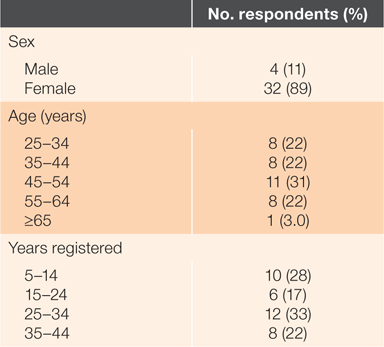
|
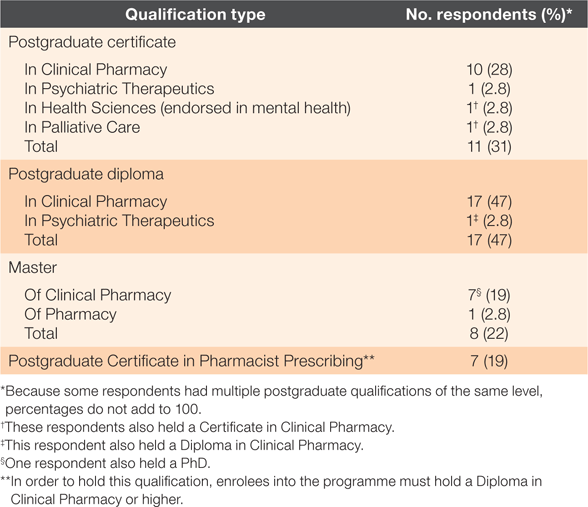
|
Location and practice characteristics
Figure 1 highlights where practice pharmacists are working in NZ. Most respondents worked in North Island general practices (n = 25), most commonly in the Hawke’s Bay (n = 8) or Wellington (n = 7) regions. Four of the six South Island respondents worked in the Otago region.
Responding pharmacists worked in 104 general practices, with 74 of these practices being in the North Island. The time spent in each practice varied from 2 to 43 h per week. Twenty-one respondents (66%) worked in general practice full-time (≥30 h per week).39 The mean (± s.d.) time spent working in general practice per week was 24.8 ± 10.7 h. One pharmacist worked across 29 practices, but the remainder worked in five or fewer practices. Fourteen respondents worked in one practice only and, of these, five worked full-time in that practice.
The number of enrolled patients in each practice varied from 600 to 28 000 (median 7400; interquartile range (IQR) 4039–12 000).
Employment and funding
Table 3 illustrates where practice pharmacists had worked previously. Most respondents had experience working in more than one setting, with 13 (36%) having worked in both community and hospital pharmacy, 4 (11%) having worked in both hospital pharmacy and PHOs and 11 (31%) having worked in community pharmacy, hospital pharmacy and PHOs. Some pharmacists had worked elsewhere, such as for government agencies and non-governmental organisations.
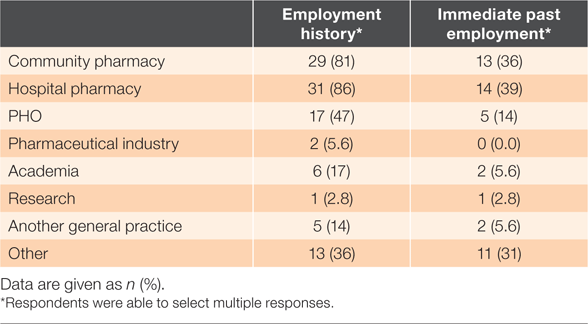
|
Analyses from this point onwards were derived from 35 respondents (as one exited the questionnaire here), of whom 12 (34%) were concurrently employed in other areas. Five were also employed in community pharmacy, two in hospital pharmacy, four as independent consultants and six in other areas, including mobile medicines therapy assessment and locum work.
The most common sole employers were PHOs (n = 18; 51%), followed by DHBs (n = 7; 20%). Three pharmacists were employed directly by practices, one by a community pharmacy, and three were independent contractors. Four respondents had a mixed employment model, being employed by a variety of employers including practices, DHBs and/or PHOs. The median time that respondents had been working in their current positions was two years and five months (IQR 1.25–4.67 years).
Table 4 highlights the sources of funding for the practice pharmacist positions. The general practice pharmacist position was most commonly funded by either DHBs (n = 14; 40%) or PHOs (n = 12; 34%). Four pharmacists were funded directly by practices, and five had a mixed funding model.
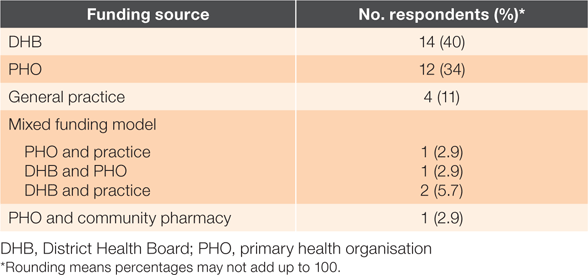
|
Roles
There was large variation in the number of patients seen each week (median 7 patients; IQR 3.5–20 patients). Table 5 lists the various roles practice pharmacists held within their practices. All seven respondents who were qualified as pharmacist prescribers were prescribing for patients with various long-term conditions in their practices, including cardiovascular disease and risk reduction, gout, diabetes, chronic pain, arthritis and chronic obstructive pulmonary disease. One pharmacist was responsible for hepatitis C prescribing.
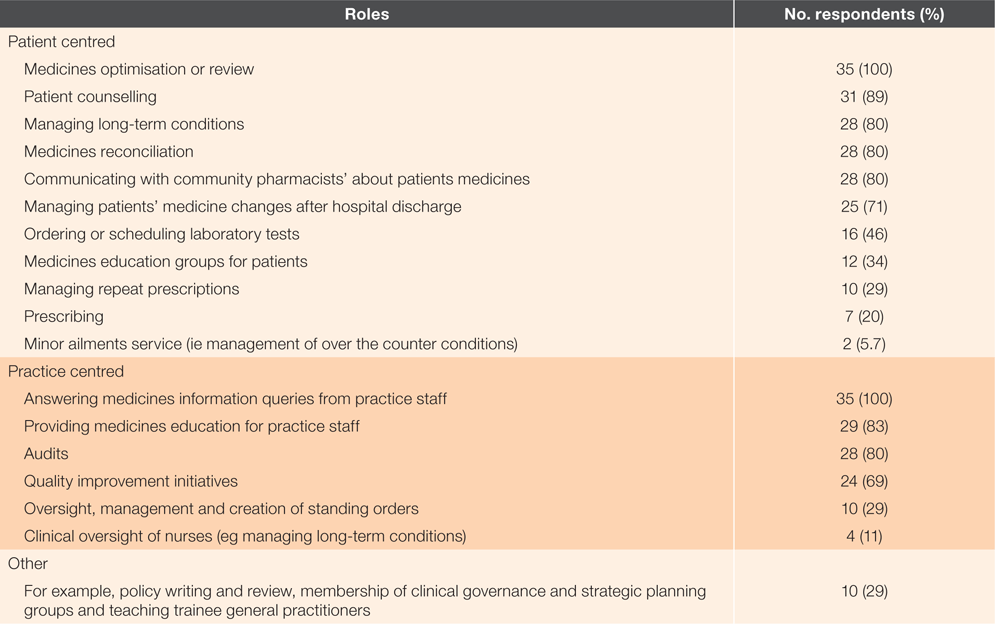
|
Of the pharmacists who were not prescribers, 16 (57%) believed being able to prescribe would benefit their practice and 12 (43%) were unsure.
Examples of audits completed by pharmacists included high-risk medicines, such as lithium or anticoagulants, as well as monitoring targets for medicines (eg urate levels with allopurinol use) and bpacnz audits.
Changes to practice
All respondents felt that since working in general practice their access to patients’ clinical information, communication with GPs, and rapport with GPs had increased or greatly increased. Most respondents also reported this for their application of pharmaceutical knowledge (n = 30; 94%), interdisciplinary collaboration (n = 27; 84%) and job satisfaction (n = 30; 94%). Further changes are listed in Table 6.
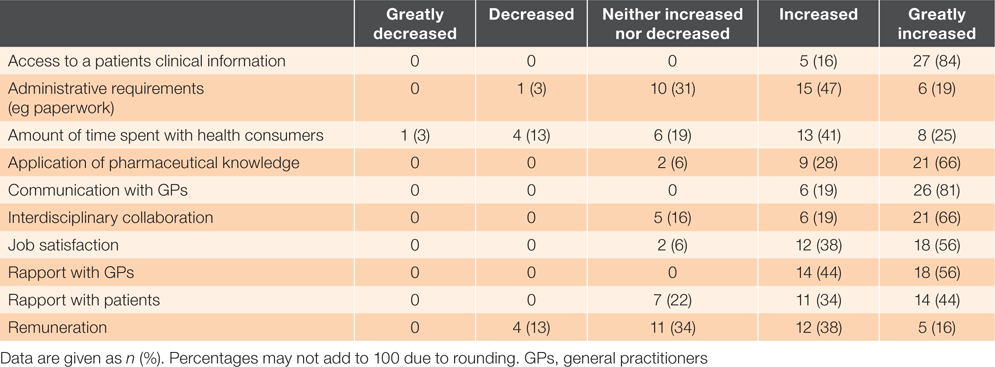
|
Benefits and challenges of integration and collaboration
The benefits and challenges of integration and collaboration are listed in Table 7. For several respondents, funding was the main limiting factor. Some perceived a lack of understanding about the value and scope of practice pharmacists. This, along with the lack of existing relationships and rapport with practice staff, meant that the initial integration process was challenging for several pharmacists. However, some respondents reported that, as trusting and collaborative relationships developed, they became valued members of the practice team:
Initially, the practice staff were unsure of the value of a pharmacist. Now, they would not be without us. (R6)
It has been difficult to break down some of the barriers going into general practice. However, with perseverance and small steps these relationships are often now filled with trust and collaboration, and in some cases the GP will often wait to consult with me before moving forward with changes. (R11)

|
Information about what the role encompasses would have been useful, because the role can be daunting initially. Training and preparing the future pharmacist workforce for general practice roles were also suggested as a way to assist integration. Respondents believed this could extend to providing on-going, dedicated education and training, and incorporating practice pharmacists in a career progression framework.
Many pharmacists commented that the role was very rewarding, and provided an opportunity to develop their niche expertise in medicines management. For some, becoming pharmacist prescribers enabled them to be more effective in their existing role; for example, undertaking repeat prescribing allowed pharmacist identification of patients who would benefit from their input and medicines optimisation. Pharmacists felt that their role benefited patients, especially patients from high-needs populations, freed up GP time and helped answer community pharmacists’ questions.
Having greater access to patients’ clinical notes was reported as hugely beneficial. One former community pharmacist found that working in general practice highlighted the paucity of patient information available to community pharmacists, limiting the level of care that can be provided:
This is especially important if we are expecting community pharmacists to provide more clinical services in primary care. From experience, you can’t apply the knowledge you have without knowing the health issues that affect a particular patient. (R10)
Working in general practice allowed pharmacists to take a more integrative approach to health care delivery, which facilitated increased uptake of pharmacist recommendations to GPs and promoted the role of pharmacists. Some respondents felt isolated from their pharmacist colleagues and, apart from one who received clinical supervision, there was a lack of professional support, including from peers. For some pharmacists, working across multiple practices made it difficult to build rapport and trust with individual practice teams.
Many respondents emphasised the need for more practice pharmacists in order to meet an unmet need, which respondents believed is currently unrecognised by many GPs. Some respondents commented that the costs of employing practice pharmacists are more than offset by the differences made to the wellbeing of patients and cost savings to DHBs.
Discussion
This study aimed to understand pharmacist integration into general practice, with results highlighting that the role is not yet widespread. Hawke’s Bay DHB has pioneered pharmacists working in this setting, with unsustainable growth in medicine volumes and costs leading to a decision to fund two pharmacists in general practice in 2011.31 In Year 2, a reduction in medicine costs of 10.8% with NZ$848 000 in savings was attributed to the impact of the practice pharmacists, equating to a 4 : 1 return on investment.31 If the savings attributed to the Hawke’s Bay practice pharmacists were replicated across DHBs nationally, the potential economic benefits to the health system are significant.
All but one responding pharmacist held clinical pharmacy postgraduate qualifications, and 81% of respondents were at least 10 years post-registration: some respondents highlighted having career experience as a specific role facilitator. These findings suggest that the practice pharmacist role in NZ suits pharmacists with postgraduate clinical qualifications and prior experience of practicing as a pharmacist. PHOs were the most common employer of responding practice pharmacists but the funding sources for the positions were evenly split between DHBs and PHOs. The implication is that PHOs may have contracts with, and receive funding from, DHBs to employ pharmacists across their practices. It is important to determine economically viable funding models that ensure ongoing sustainability for the role, because a lack of secure funding was highlighted as a major barrier to increasing the number of pharmacists working in general practice.
Many respondents’ time was split across multiple practices, and for some this was considered a barrier to building rapport and trust with practice staff. Time spent in a practice has been reported to influence the types of roles held, with full-time practice pharmacists typically taking on more roles than part-time pharmacists.35 In the evaluation of the English pilot scheme, one of the biggest problems raised in the scheme was pharmacists working part-time.40
The roles that respondents hold focus strongly on direct patient care, with supplementary roles designed to improve practice efficiencies and the effectiveness of other clinicians. These findings align with reports from Australia, Canada and England,34,35,41 although pharmacist prescribing in general practice occurs at much higher levels in England, where a prescribing qualification is mandatory and prescribing is recognised as a core role of practice pharmacists.42,43 Factors affecting the slow uptake of pharmacist prescribing in NZ are multifaceted, but may include a lack of funding for continuing education opportunities, an absence of established roles in practice and resistance from other health professionals.44 Much like the UK,23 current trends in the NZ primary care workforce point towards a need for more resources to meet the increased health care demands facing general practice.20 Placing more pharmacists in general practice, particularly those who can prescribe, may help to meet these needs.
Tasks not typically performed by respondents included clinical oversight of practice nurses, creating and managing standing orders, providing medicines education groups for patients and ordering or scheduling laboratory tests. These tasks could be perceived as the traditional responsibility of other practice staff, or perhaps are not provided by the practices in our study. These lower rates in NZ could also possibly reflect issues of role encroachment.45–47 However, research consistently highlights the initial reservations of practice staff dissipate over time, and the pharmacist becomes an integral part of the multidisciplinary team.48–51 Some of our respondents also mentioned this. It is important that general practice pharmacists are given time and opportunity to build rapport and relationships with practice staff, and to demonstrate how they can add value to patient care and the overall running of practices. The evaluation of the English pilot scheme found that GPs are unlikely to realise the benefits of having a pharmacist embedded within the practice until after the first year of integration.40
Respondents felt that working in general practice had positively influenced various aspects of their practice. In particular, job satisfaction increased or greatly increased for 94% of respondents. For pharmacists coming from a hospital background, this may reflect more meaningful longer-term personal interactions and relationships with patients. For community pharmacists, this may arise from making better use of their knowledge and expertise regarding medicines. This is supported by reports of job satisfaction for pharmacists being positively linked with the degree to which cognitive and clinical activities are performed.52–54
Strengths and limitations
This study used a comprehensive recruitment strategy to describe the characteristics of practice pharmacists in NZ. It therefore provides baseline data allowing developments in this area to be monitored.
Not every pharmacist working in general practice completed the questionnaire, so the study’s representation of practice pharmacists is incomplete. Although the free-text responses generated some consistent themes, a small number of pharmacists contributed most of the free-text data, so these findings may not be generalisable to all general practice pharmacists.
Implications
Further research that seeks to explore the views of patients and other health-care professionals, and compares and contrasts different models of pharmacist integration into general practice, may provide insights to ensure further integration occurs efficiently and achieves maximum benefits for all parties involved. When pharmacists apply for their Annual Practicing Certificate, they have the opportunity to select their type of work, but currently there is no ‘general practice’ option. The Pharmacy Council should consider adding an option for this group of pharmacists, so that their numbers can be accurately reported and monitored over time.
The results highlight the value of having guidelines to describe the role. Clarity around practice pharmacists’ scope of practice would be useful to allow GPs to have a clear understanding about how a pharmacist may fit within their practice. A code of practice is currently under development by the Pharmacy Council,55 and this should be a useful tool for both practices and pharmacists moving forward. Efforts to formalise ongoing education, training and support for practice pharmacists should also be considered.
Conclusion
This research describes the current landscape of pharmacist integration into general practice in NZ. The findings are consistent with previous reports suggesting the role has been taken up more in particular regions of the country. Pharmacists in these roles tend to be experienced and have completed postgraduate study. The role has facilitated improved communication and rapport with GPs, interdisciplinary collaboration, application of pharmaceutical knowledge and job satisfaction. Barriers to integration included system-level difficulties around funding and a lack of understanding about the skill and knowledge set of pharmacists. Overcoming these will be important for role expansion as NZ seeks to achieve the aims of the New Zealand Health Strategy and Pharmacy Action Plan.
Competing interests
The authors have no conflicts of interest to declare.
Acknowledgements
The authors thank the Pharmaceutical Society of New Zealand, and the Clinical Advisory Pharmacists’ Association for sending out invitations for pharmacists to complete their questionnaire. The authors also thank the PHO chief executive officers who took the time to assist with recruitment, along with the Midland and Canterbury Community Pharmacy Groups. The authors thank the pharmacists who completed our questionnaire, and pharmacists who forwarded on the questionnaire to other pharmacists. Finally, the authors acknowledge the input and advice from Dianne Vicary and Adele Print, who are advisors for this project and offered their expert opinion about the content of the questionnaire. This research was supported by funding from the Sylff Association.
References
[1] Mossialos E, Djordjevic A, Osborn R, Sarnak D, eds. International profiles of health care systems. New York: The Commonwealth Fund; 2017. [Cited 2018 November 3]. Available from: http://www.commonwealthfund.org/~/media/files/publications/fund-report/2017/may/mossialos_intl_profiles_v5.pdf?la=en[2] Ministry of Health. About primary health organisations. Wellington: Ministry of Health; [Cited 2019 April 8]. Available from: http://www.health.govt.nz/our-work/primary-health-care/about-primary-health-organisations
[3] Pharmacy Council of New Zealand. Workforce demographic. Wellington: Pharmacy Council of New Zealand; 2018. [Cited 2019 March 16]. Available from: http://www.pharmacycouncil.org.nz/Portals/12/Documents/Final%20workforce%20demographic%20report%202018.pdf?ver=2018-11-07-004558-427
[4] Ministry of Health. New Zealand health strategy: future direction. Wellington: Ministry of Health; 2016. [Cited 2018 October 10]. Available from: https://www.health.govt.nz/system/files/documents/publications/new-zealand-health-strategy-futuredirection-2016-apr16.pdf
[5] Ministry of Health. Pharmacy Action Plan: 2016 to 2020. Wellington (New Zealand): Ministry of Health; 2016. [Cited 2018 October 10]. Available from: https://www.health.govt.nz/system/files/documents/publications/pharmacy-action-plan-2016-to-2020.pdf
[6] Claesson CB, Burman K, Nilsson JL, Vinge E. Prescription errors detected by Swedish pharmacists. Int J Pharm Pract 1995; 3 151–6.
| Prescription errors detected by Swedish pharmacists.Crossref | GoogleScholarGoogle Scholar |
[7] Khoja T, Neyaz Y, Quresh N, et al. Medication errors in primary care in Riyadh city, Saudi Arabia. East Mediterr Health J 2011; 17 156–9.
| Medication errors in primary care in Riyadh city, Saudi Arabia.Crossref | GoogleScholarGoogle Scholar | 21735951PubMed |
[8] Zavaleta-Bustos M, Castro-Pastrana LI, Reyes-Hernández I, et al. Prescription errors in a primary care university unit: urgency of pharmaceutical care in Mexico. Rev Bras Cienc Farm. 2008; 44 115–25.
| Prescription errors in a primary care university unit: urgency of pharmaceutical care in Mexico.Crossref | GoogleScholarGoogle Scholar |
[9] Avery AA, Ghaleb M, Barber N, et al. The prevalence and nature of prescribing and monitoring errors in English general practice: a retrospective case note review. Br J Gen Pract. 2013; 63(613): e543–53.
[10] PHARMAC. Year in Review 2018. Wellington (New Zealand): PHARMAC; 2018. [Cited 2019 March 19]. Available from: https://www.pharmac.govt.nz/assets/year-in-review-2018.pdf
[11] Patel KJ, Kedia MS, Bajpai D, et al. Evaluation of the prevalence and economic burden of adverse drug reactions presenting to the medical emergency department of a tertiary referral centre: a prospective study. BMC Clin Pharmacol 2007; 7 8
| Evaluation of the prevalence and economic burden of adverse drug reactions presenting to the medical emergency department of a tertiary referral centre: a prospective study.Crossref | GoogleScholarGoogle Scholar | 17662147PubMed |
[12] Pirmohamed M, James S, Meakin S, et al. Adverse drug reactions as cause of admission to hospital: prospective analysis of 18 820 patients. BMJ 2004; 329 15–9.
| Adverse drug reactions as cause of admission to hospital: prospective analysis of 18 820 patients.Crossref | GoogleScholarGoogle Scholar | 15231615PubMed |
[13] Alexopoulou A, Dourakis SP, Mantzoukis D,, et al. Adverse drug reactions as a cause of hospital admissions: a 6-month experience in a single center in Greece. Eur J Intern Med 2008; 19 505–10.
| Adverse drug reactions as a cause of hospital admissions: a 6-month experience in a single center in Greece.Crossref | GoogleScholarGoogle Scholar | 19013378PubMed |
[14] Robb G, Loe E, Maharaj A, et al. Medication-related patient harm in New Zealand hospitals. N Z Med J 2017; 130 21–32.
| 28796769PubMed |
[15] Royal S, Smeaton L, Avery A, et al. Interventions in primary care to reduce medication related adverse events and hospital admissions: systematic review and meta-analysis. Qual Saf Health Care 2006; 15 23–31.
| Interventions in primary care to reduce medication related adverse events and hospital admissions: systematic review and meta-analysis.Crossref | GoogleScholarGoogle Scholar | 16456206PubMed |
[16] Romanelli RJ, Leahy A, Jukes T, Ishisaka DY. Pharmacist-led medication management program within a patient-centered medical home. Am J Health Syst Pharm 2015; 72 453–9.
| Pharmacist-led medication management program within a patient-centered medical home.Crossref | GoogleScholarGoogle Scholar | 25736939PubMed |
[17] Hazen AC. Non-dispensing clinical pharmacists in general practice: training, implementation and clinical effects. PhD Thesis, Utrecht University; 2018.
[18] Avery AJ, Rodgers S, Cantrill JA, et al. A pharmacist-led information technology intervention for medication errors (PINCER): a multicentre, cluster randomised, controlled trial and cost-effectiveness analysis. Lancet 2012; 379 1310–19.
| A pharmacist-led information technology intervention for medication errors (PINCER): a multicentre, cluster randomised, controlled trial and cost-effectiveness analysis.Crossref | GoogleScholarGoogle Scholar | 22357106PubMed |
[19] Tan EC, Stewart K, Elliott RA, George J. Pharmacist services provided in general practice clinics: a systematic review and meta-analysis. Res Social Adm Pharm 2014; 10 608–22.
| Pharmacist services provided in general practice clinics: a systematic review and meta-analysis.Crossref | GoogleScholarGoogle Scholar | 24161491PubMed |
[20] Royal New Zealand College of General Practitioners. 2017 general practice workforce survey. Wellington: Royal New Zealand College of General Practitioners; 2017. [Cited 2018 November 20]. Available from: https://oldgp16.rnzcgp.org.nz/assets/Workforce-Survey-2017-Report-1-final.pdf
[21] New Zealand Nurses Organisation (NANO). NZNO employment survey 2017. Wellington: NZNO; 2017. [Cited 2018 November 20]. Available from: https://www.nzno.org.nz/LinkClick.aspx?fileticket=C1q0M5fBavA%3D&portalid=0
[22] NHS England. Clinical pharmacists in general practice. Leeds: NHS England. [Cited 21 February 2018]. Available from: https://www.england.nhs.uk/gp/gpfv/workforce/building-the-general-practice-workforce/cp-gp/
[23] NHS England. General practice forward view. Leeds: NHS England; 2016. [Cited 2018 October 27]. Available from: https://www.england.nhs.uk/wp-content/uploads/2016/04/gpfv.pdf
[24] Foot H, Freeman C, Hemming K, et al. Reducing medical admissions into hospital through optimising medicines (REMAIN HOME) study: protocol for a stepped-wedge, cluster-randomised trial. BMJ Open 2017; 7 e015301
| Reducing medical admissions into hospital through optimising medicines (REMAIN HOME) study: protocol for a stepped-wedge, cluster-randomised trial.Crossref | GoogleScholarGoogle Scholar | 28408545PubMed |
[25] Australian Medical Association (AMA). General practice pharmacists – improving patient care. Canberra: AMA; 2015. [Cited 2018 November 21]. Available from: https://ama.com.au/system/tdf/documents/Pharmacists_in_General_Practice_Proposal.pdf?file=1&type=node&id=42083
[26] Dolovich L, Pottie K, Kaczorowski J, et al. Integrating family medicine and pharmacy to advance primary care therapeutics. Clin Pharmacol Ther 2008; 83 913–7.
| Integrating family medicine and pharmacy to advance primary care therapeutics.Crossref | GoogleScholarGoogle Scholar | 18388882PubMed |
[27] Coe AB, Choe HM. Pharmacists supporting population health in patient-centered medical homes. Am J Health Syst Pharm 2017; 74 1461–6.
| Pharmacists supporting population health in patient-centered medical homes.Crossref | GoogleScholarGoogle Scholar | 28887347PubMed |
[28] American Society of Health-System Pharmacists ASHP statement on the pharmacist’s role in primary care. Am J Health Syst Pharm 1999; 56 1665–7.
| ASHP statement on the pharmacist’s role in primary care.Crossref | GoogleScholarGoogle Scholar | 10459388PubMed |
[29] NHS England. More than 400 pharmacists to be recruited to GP surgeries by next year. Leeds: NHS England; 2015. [Cited 26 July 2018]. Available from: https://www.england.nhs.uk/2015/11/pharmacists-recruited/
[30] Midlands Health Network. Clinical pharmacy in general practice: a review of the first nine months. Hamilton: Midlands Health Network; 2012. [Cited 2018 October 3]. Available from: https://www.midlandshn.health.nz/uploads/clinical-pharmacy-in-general-practice-review-web.pdf
[31] Duck B, Brown V, Allan W, et al. Better than an iPad app, a clinical pharmacist in your practice. Int J Integr Care 2017; 17 A107
| Better than an iPad app, a clinical pharmacist in your practice.Crossref | GoogleScholarGoogle Scholar |
[32] WellSouth Primary Health Network. 2017 annual report. Dunedin: WellSouth Primary Health Network; 2017. [Cited 2018 October 3]. Available from: https://issuu.com/wellsouth/docs/annual_report_final_2017/2?ff=true&e=31017357/55601775
[33] Campbell C, Braund R, Morris C. Beyond the four walls: an exploratory survey of location, employment and roles of pharmacists in primary health care. J Prim Health Care 2017; 9 297–310.
| Beyond the four walls: an exploratory survey of location, employment and roles of pharmacists in primary health care.Crossref | GoogleScholarGoogle Scholar | 29530142PubMed |
[34] Freeman C, Cottrell N, Rigby D, et al. The Australian practice pharmacist. J Pharm Pract Res. 2014; 44 240–8.
| The Australian practice pharmacist.Crossref | GoogleScholarGoogle Scholar |
[35] Gillespie U, Dolovich L, Dahrouge S. Activities performed by pharmacists integrated in family health teams: results from a web-based survey. Can Pharm J 2017; 150 407–16.
| Activities performed by pharmacists integrated in family health teams: results from a web-based survey.Crossref | GoogleScholarGoogle Scholar |
[36] Pharmacy Council of New Zealand. 2017 workforce demographic. Wellington: Pharmacy Council of New Zealand; 2017. [Cited 2018 September 16]. Available from: http://www.pharmacycouncil.org.nz/Portals/12/2017%20Workforce%20Demographic%20Report.pdf?ver=2017-10-19-093636-617
[37] IBM Corp. IBM SPSS Statistics for Windows, Version 25.0. Armonk, NY: IBM Corp.; 2017.
[38] NVivo. NVivo qualitative data analysis software, Version 11. QSR International Pty Ltd; 2015.
[39] Stats NZ. Definition of full time work. Wellington: Stats NZ; [Cited 25 October 2018]. Available from: http://datainfoplus.stats.govt.nz/Item/nz.govt.stats/bb283376-7537-48d6-9c3f-7a20b6b84c27
[40] Mann C, Anderson C, Avery AJ, et al. Clinical pharmacists in general practice: pilot scheme. Independent evaluation report: full report. Nottingham: University of Nottingham; 2018. [Cited 2018 December 11]. Available from: https://www.nottingham.ac.uk/pharmacy/documents/generalpracticeyearfwdrev/clinical-pharmacists-in-general-practice-pilot-scheme-full-report.pdf
[41] Bradley F, Seston E, Mannall C, Cutts C. Evolution of the general practice pharmacist’s role in England: a longitudinal study. Br J Gen Pract 2018; 68 e727–34.
| 30154077PubMed |
[42] Centre for Pharmacy Postgraduate Education. General practice pharmacist training pathway – pathway handbook. Manchester: Centre for Pharmacy Postgraduate Education; 2016. [Cited 2018 December 15]. Available from: https://www.cppe.ac.uk/learningdocuments/pdfs/gpptp%20pathway%20handbook.pdf
[43] NHS England. Enhanced service specification – clinical pharmacists in general practice phase 2 programme. Leeds: NHS England; 2017. [Cited 2018 December 15]. Available from: https://www.england.nhs.uk/wp-content/uploads/2017/11/enhanced-service-clinical-pharmacists-gp.pdf
[44] Officer TN. Nurse practitioners and pharmacist prescribers in primary health care: a realist evaluation of the New Zealand experience. PhD Thesis, Victoria University of Wellington; 2018.
[45] Scahill S, Harrison J, Sheridan J. The ABC of New Zealand’s ten year vision for pharmacists: awareness, barriers and consultation. Int J Pharm Pract 2009; 17 135–42.
| The ABC of New Zealand’s ten year vision for pharmacists: awareness, barriers and consultation.Crossref | GoogleScholarGoogle Scholar | 20218244PubMed |
[46] Bidwell S, Thompson L. GPs, community pharmacists and shifting professional boundaries. N Z Med J 2015; 128 19–26.
| 26117387PubMed |
[47] Bryant L, Coster G, McCormick R. General practitioner perceptions of clinical medication reviews undertaken by community pharmacists. J Prim Health Care 2010; 2 225–33.
| General practitioner perceptions of clinical medication reviews undertaken by community pharmacists.Crossref | GoogleScholarGoogle Scholar | 21069118PubMed |
[48] Kozminski M, Busby R, McGivney MS, et al. Pharmacist integration into the medical home: qualitative analysis. J Am Pharm Assoc 2011; 51 173–83.
| Pharmacist integration into the medical home: qualitative analysis.Crossref | GoogleScholarGoogle Scholar |
[49] Pottie K, Haydt S, Farrell B, et al. Pharmacist’s identity development within multidisciplinary primary health care teams in Ontario; qualitative results from the IMPACT project. Res Social Adm Pharm 2009; 5 319–26.
| Pharmacist’s identity development within multidisciplinary primary health care teams in Ontario; qualitative results from the IMPACT project.Crossref | GoogleScholarGoogle Scholar | 19962675PubMed |
[50] Tan EC, Stewart K, Elliott RA, George J. Stakeholder experiences with general practice pharmacist services: a qualitative study. BMJ Open 2013; 3 e003214
| Stakeholder experiences with general practice pharmacist services: a qualitative study.Crossref | GoogleScholarGoogle Scholar | 24030867PubMed |
[51] Ryan K, Patel N, Lau WM, et al. Pharmacists in general practice: a qualitative interview case study of stakeholders’ experiences in a West London GP federation. BMC Health Serv Res 2018; 18 234
| Pharmacists in general practice: a qualitative interview case study of stakeholders’ experiences in a West London GP federation.Crossref | GoogleScholarGoogle Scholar | 29609603PubMed |
[52] Cox ER, Fitzpatrick V. Pharmacists’ job satisfaction and perceived utilization of skills. Am J Health Syst Pharm 1999; 56 1733–7.
| Pharmacists’ job satisfaction and perceived utilization of skills.Crossref | GoogleScholarGoogle Scholar | 10512504PubMed |
[53] Seston E, Hassell K, Ferguson J, Hann M. Exploring the relationship between pharmacists’ job satisfaction, intention to quit the profession, and actual quitting. Res Social Adm Pharm 2009; 5 121–32.
| Exploring the relationship between pharmacists’ job satisfaction, intention to quit the profession, and actual quitting.Crossref | GoogleScholarGoogle Scholar | 19524860PubMed |
[54] Olson DS, Lawson KA. Relationship between hospital pharmacists’ job satisfaction and involvement in clinical activities. Am J Health Syst Pharm 1996; 53 281–4.
| Relationship between hospital pharmacists’ job satisfaction and involvement in clinical activities.Crossref | GoogleScholarGoogle Scholar | 8808024PubMed |
[55] Pharmacy Council of New Zealand. October 2018 newsletter. Wellington: Pharmacy Council of New Zealand; 2018. [Cited 2018 December 13]. Available from: http://www.pharmacycouncil.org.nz/Portals/12/Documents/Newsletters/Newsletter%20Oct%202018%20FINAL.pdf?ver=2018-10-26-020100-890


